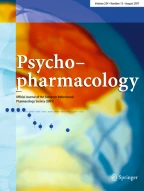784Accesses
261Citations
3 Altmetric
Abstract.
Rationale: We reported previously that bilateral injection of a corticotropin-releasing factor (CRF)-receptor antagonist, D-Phe CRF12–41, into the bed nucleus of the stria terminalis (BNST) blocks the reinstatement of cocaine seeking induced by footshock, whereas the injection of CRF into the same region induces reinstatement. One source of CRF in the BNST arises from a CRF-containing projection originating in the central nucleus of the amygdala (CeA). Objective: To determine whether the CRF-containing projection from the amygdala to the BNST is involved in the mediation of stress-induced reinstatement of cocaine seeking by functionally interrupting the pathway. Methods: Rats trained to self-administer cocaine (1 mg/kg, IV, 9 days) were given extinction sessions after a 10- to 11-day drug-free period, followed by tests for stress-induced reinstatement (footshock: 15 min intermittent 0.8-mA footshocks given immediately before presentation of the previously active lever). Before the tests, animals were pretreated with either: (1) TTX (2.5 ng) in amygdala (including the CeA) in one hemisphere and D-Phe CRF12–41 (50 ng) in BNST in the other, (2) unilateral TTX, or (3) unilateral D-Phe. Results: Footshock reinstated cocaine seeking following unilateral injections of either TTX in amygdala or D-Phe in BNST, but following the injection of both TTX in amygdala and D-Phe in BNST the effects of footshock were greatly attenuated. Conclusion: These results suggest that the CRF-containing pathway from CeA to BNST is involved in mediating the effects of CRF and its receptor antagonist in the BNST on the reinstatement of cocaine seeking.
This is a preview of subscription content,log in via an institution to check access.
Access this article
Subscribe and save
- Starting from 10 chapters or articles per month
- Access and download chapters and articles from more than 300k books and 2,500 journals
- Cancel anytime
Buy Now
Price includes VAT (Japan)
Instant access to the full article PDF.
Similar content being viewed by others
Explore related subjects
Discover the latest articles, books and news in related subjects, suggested using machine learning.Author information
Authors and Affiliations
Center for Studies in Behavioral Neurobiology, Department of Psychology, Concordia University, 1455 de Maisonneuve Blvd, Montreal, Quebec, Canada H3G 1M8, , , , ,
Suzanne Erb, Natalina Salmaso, Demetra Rodaros & Jane Stewart
- Suzanne Erb
Search author on:PubMed Google Scholar
- Natalina Salmaso
Search author on:PubMed Google Scholar
- Demetra Rodaros
Search author on:PubMed Google Scholar
- Jane Stewart
Search author on:PubMed Google Scholar
Additional information
Electronic Publication
Rights and permissions
About this article
Cite this article
Erb, S., Salmaso, N., Rodaros, D.et al. A role for the CRF-containing pathway from central nucleus of the amygdala to bed nucleus of the stria terminalis in the stress-induced reinstatement of cocaine seeking in rats.Psychopharmacology158, 360–365 (2001). https://doi.org/10.1007/s002130000642
Received:
Accepted:
Issue date:
Share this article
Anyone you share the following link with will be able to read this content:
Sorry, a shareable link is not currently available for this article.
Provided by the Springer Nature SharedIt content-sharing initiative
Profiles
- Natalina SalmasoView author profile



